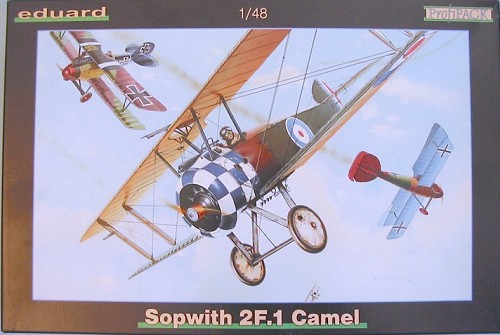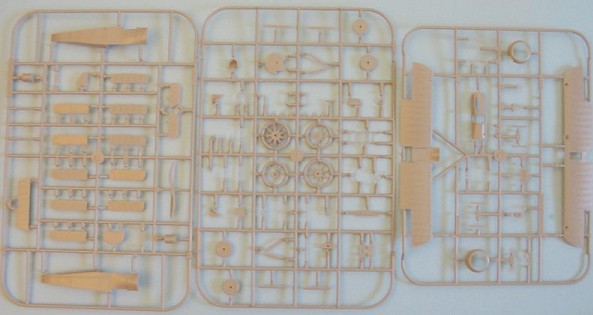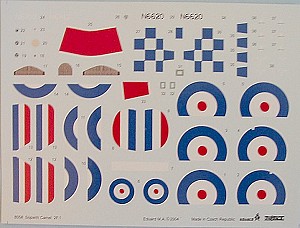
|
KIT: |
Eduard 1/48 Sopwith 2.F1 Camel |
|
KIT # |
8058 |
|
PRICE: |
$34.95 MSRP |
|
DECALS: |
three options |
|
REVIEWER: |
Tom Cleaver |
|
NOTES: |
Profipack version |

|
HISTORY |
Given that it was no more easy to land an airplane on the deck of an aircraft carrier in 1918 than it is today - that in fact it was more difficult - it is nothing short of amazing that the world’s first successful carrier-based fighter would be a development of a design that is uniformly regarded as the trickiest and most difficult-to-fly fighter used by either side in the First World War, the Sopwith Camel.
The 2.F1 “Sea Camel” was a development of the standard F.1 Camel with differences such as a rear fuselage which could be removed for storage, a different upper wing, and provision for only one machine gun in the standard forward fuselage position, a second weapon being provided by a Lewis gun mounted on the upper wing that could be aimed upwards. This was because of the fact that the Camel was originally to be a Zeppelin interceptor, and the German airships generally could be expected to have an altitude advantage over intercepting fighters. Sea Camels were also used as parasite fighters, carried for defense by Royal Navy airships on North Sea reconnaissance missions.
The Sea Camels were first flown of rafts towed by destroyers, with the intention that the pilot would alight at sea for pick-up by the destroyer following his interception mission. With the commissioning of H.M.S. “Furious” as an aircraft carrier in early 1918, however, the Camel could be used as a fleet defense fighter that could be recovered aboard. Additionally, the aircraft was modified to carry four 20-lb Cooper bombs for use as a strike aircraft. In July 1918, six Camels launched by “Furious” against the German Zeppelin base at Tondern performed the first carrier air strike in history.
|
THE KIT |

Eduard’s Camel
has already attained accolades for being the best kit of this famous
fighter to be released to date in any scale. This 2.F1 Camel largely
continues that, though the fact it is produced as one of a series of kits
with minimum changes to the molds means that there are details a modeler
will discover there is “some modeling skill required” to create an
accurate model of this variant. While the upper wing is correct, and
provision is mad e for
the differing external control wires for the rudder and elevators, the
propeller in the kit is the standard diameter prop associated with the
land-based Camel, rather than the smaller-diameter prop used by this
type. This will not be difficult to modify, however. The kit also fails
to provide the flotation bags associated with the Sea Camel, and these
will have to be scratchbuilt.
e for
the differing external control wires for the rudder and elevators, the
propeller in the kit is the standard diameter prop associated with the
land-based Camel, rather than the smaller-diameter prop used by this
type. This will not be difficult to modify, however. The kit also fails
to provide the flotation bags associated with the Sea Camel, and these
will have to be scratchbuilt.
Other than that, the Profipack version provides photo-etch detail for the cockpit and the under-fuselage bomb racks, as well as the wing control wires, and resin bombs. This is good because of the three different markings provided on the excellent decal sheet, the best and most colorful - with its blue-and-white checkerboard nose - is that for the Camel flown by Capt. B.A. Smart, the leader of the Tondern Raid. Markings are also provided for a parasite fighter carried by HMA “R.23" from 212 Squadron in 1918, and an otherwise-anonymous airplane based at Great Yarmouth.
|
CONCLUSIONS |
Eduard’s Camel continues to be a world-beater, though one will have to put in a bit of extra effort with this particular version. The result will be a very nice model of a historically-significant airplane in the history of naval aviation, and a worthy addition to any collection.
Review Kit courtesy of Eduard
If you would like your product reviewed fairly and quickly by a site that has over 250,000 visitors a month, please contact me or see other details in the Note to Contributors.